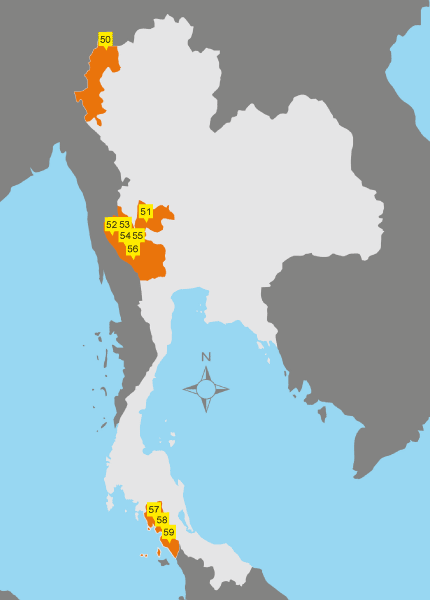
![]() ince ancient times, caves have long been in the life of Thai people due to their dependence on natural resources. According to historical evidence, caves were inhabited by humans or “cave men” and were used for many purposes. Because of their distinctive characteristics and myths, caves have inevitably become attractive destinations for tourists who thirst for adventure and challenge.
ince ancient times, caves have long been in the life of Thai people due to their dependence on natural resources. According to historical evidence, caves were inhabited by humans or “cave men” and were used for many purposes. Because of their distinctive characteristics and myths, caves have inevitably become attractive destinations for tourists who thirst for adventure and challenge.

Formation of a Cave
Plate tectonics have caused the change in sedimentary structures; such as, the rock uplift and joints (known as fractures in rock) or large faults, which later became caves once these cracks expanded. Furthermore, rainwater seeped through the bedding planes, faults and joints. Mild carbonic acid in rainwater dissolved the limestone, creating solutional caves with strange-shaped rocks inside. The dripping of mineralised water and the deposition of calcium carbonate has created spectacular stalactites and stalagmites.
Invisible Danger
For deep caves or unexplored caves, the air circulation within the cave is extremely important. If you breathe in the air with over 5.5% of carbon dioxide, you will experience difficulty in breathing, dizziness, confusion, and loss of consciousness, which could result in death within a few minutes. The safest way to check the air inside the cave is to use an electronic carbon dioxide detector. It is designed to sound an alarm once it detects dangerous levels of carbon dioxide accumulated in the air. Alternatively, body symptoms can be used as an indicator of the carbon dioxide level, but this requires caving experience to be able to tell correctly.
The low temperature inside the cave is another danger for a cave exploration. Normally, water in the cave is colder than water outside. Standing in the water for a long period of time can cause Hypothermia – the condition of abnormally low body temperature. The symptoms are shivering, slow and laboured movements, difficulty in speaking, sluggish thinking, compromised vision and mental confusion. If the body temperature drops 5-6 degrees Celsius, you can experience a loss of consciousness, which might result in death. Therefore, appropriate clothes and equipment are highly necessary in retaining your body temperature.

Caving Gear

- A climbing or caving helmet with a headlamp.
- Sturdy shoes preferably with knobby bottoms are a must.
- Backup lights with batteries.
- Jeans and a sweatshirt over another long-sleeved sweatshirt works fine.
- A good pair of gloves keep your hands happy.
- A cave pack and a large plastic trash bag.
- Knee and elbow pads, first aid kit, compass or GPS device are nice to have.
Safety Measures
Cavers around the world - amateurs, professionals, tourists - use the same safety measures to protect themselves during a cave exploration.
Great Caves of Thailand
| Place | Province | Season To Visit |
Cave Type | |
|---|---|---|---|---|
| 50 | Tham Nam Lot |
Mae Hong Son |
All year long | Limestone Cave |
| 51 | Hup Pa Tat | Uthai Thani | All year long | Limestone Cave |
| 52 | Tham Than Lot | Kanchanaburi | All year long | Limestone Cave |
| 53 | Tham Nok Nang Aen | Kanchanaburi | Mar - May | Limestone Cave |
| 54 | Tham Sao Hin | Kanchanaburi | Mar - May | Limestone Cave |
| 55 | Tham Thi Phu Che | Kanchanaburi | Oct - Jun | Limestone Cave |
| 56 | Tham Lawa | Kanchanaburi | All year long |
Limestone Cave |
| 57 | Tham Le Khao Kop | Trang | All year long |
Limestone Cave |
| 58 | Tham Morakot | Trang | All year long | Sea Cave |
| 59 | Tham Chet Khot | Satun | All year long | Limestone Cave |



